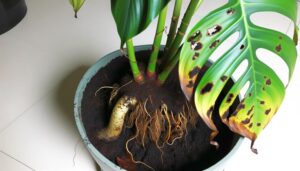What Causes White Spots on Monstera Leaves? Expert Insights!
White spots on Monstera leaves can arise from several issues. Pest infestations like spider mites and scale insects puncture leaves, leaving characteristic spots.
Fungal infections such as powdery mildew thrive in humid, poorly ventilated environments, creating white fuzz. Bacterial diseases, including bacterial leaf spot, lead to angular, water-soaked lesions.
Nutrient deficiencies, particularly calcium, magnesium, and iron, result in chlorotic and necrotic spots. Improper watering practices, whether overwatering or underwatering, stress the plant, causing similar damage.
Addressing these issues early can prevent further spread and damage. For a deeper understanding of these causes and their solutions, explore specific methods and care tips.
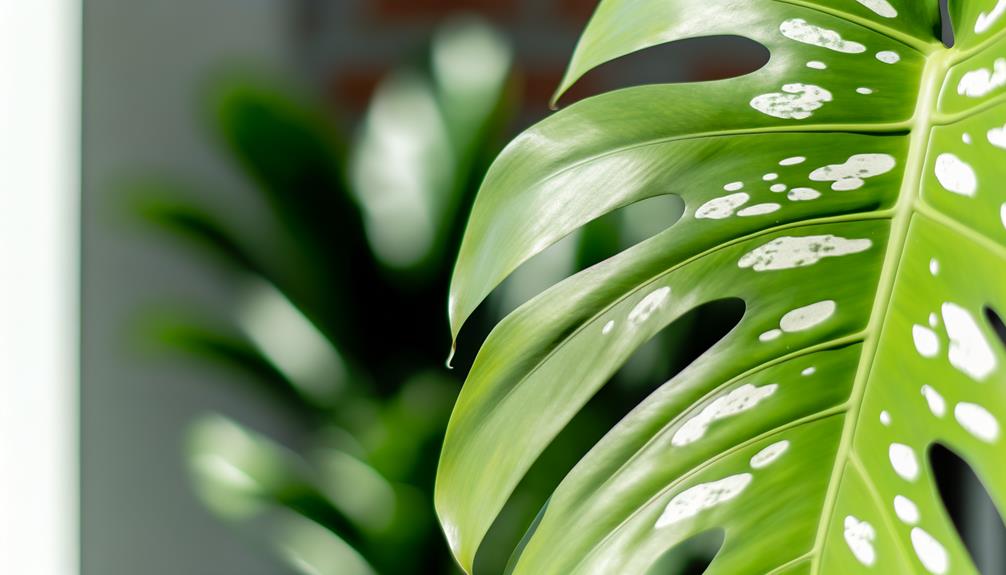
Key Takeaways
- Pest infestations, like spider mites and scale insects, cause white spots.
- Fungal infections, such as powdery mildew and botrytis, result in white spots.
- Bacterial diseases, including bacterial leaf spot and blight, lead to white spots.
- Nutrient deficiencies, particularly in calcium, magnesium, and iron, cause white spots.
- Watering issues, both overwatering and underwatering, can produce white spots.
Pest Infestations

Pest infestations, particularly those involving spider mites and scale insects, are a common cause of white spots on Monstera leaves. You’ll find that spider mites, tiny arachnids, puncture the leaf surface to suck out sap, leading to stippled white spots. Use a magnifying glass to spot their fine webbing, confirming their presence.
Scale insects, on the other hand, attach themselves to the leaf and secrete a waxy coating, creating white, raised spots. Monitoring for these pests is crucial; check the undersides of leaves and stems.
Implementing a treatment plan involving insecticidal soap or neem oil can manage these infestations effectively. Consistent care and vigilance will guarantee your Monstera remains healthy and free from these damaging pests.
Fungal Infections
Fungal infections can manifest as white spots on Monstera leaves, often resulting from pathogens like powdery mildew or botrytis.
Powdery mildew typically appears as a white, powdery substance on the leaf surface, thriving in humid conditions with poor air circulation.
Botrytis, also known as gray mold, causes water-soaked spots that turn white and fuzzy, particularly in damp environments.
You’ll notice these infections increase in severity if the plant is continuously exposed to high humidity and stagnant air.
To manage fungal infections, improve air circulation around your Monstera by spacing plants appropriately and using a fan if necessary. Applying fungicides can also help control the spread.
Regularly inspect your plant for early signs to mitigate extensive damage effectively.
Bacterial Diseases
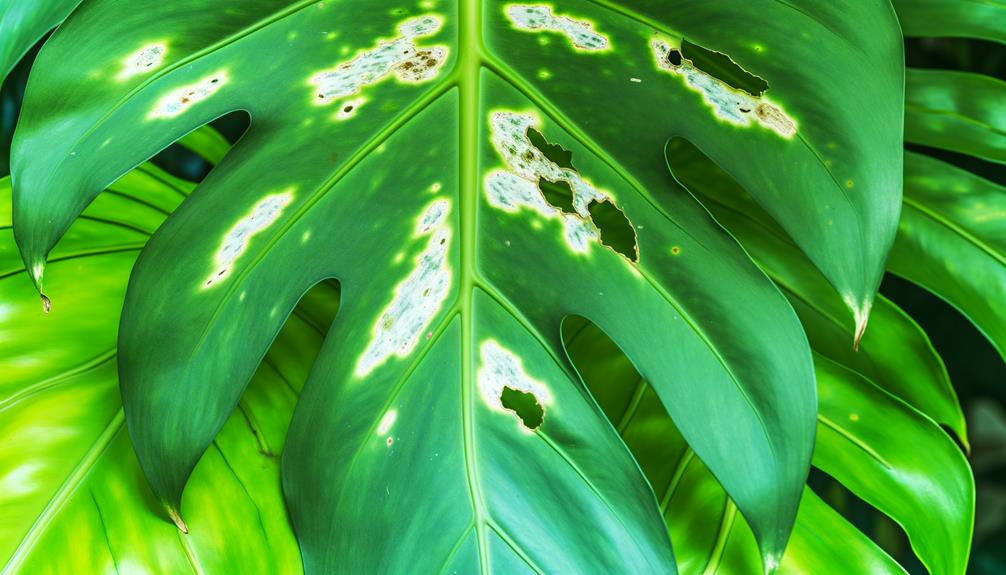
Bacterial diseases, such as bacterial leaf spot and bacterial blight, can also cause white spots on Monstera leaves, often characterized by angular lesions with a water-soaked appearance. You’ll notice that these lesions may expand, turning brown and necrotic over time. Pathogens like Xanthomonas campestris and Pseudomonas syringae are common culprits.
These bacteria thrive in high humidity and warm temperatures, penetrating leaf tissue through stomata or wounds. To manage bacterial infections, ensure proper air circulation and avoid overhead watering.
Prune affected leaves with sterilized tools to prevent further spread. Copper-based bactericides can provide some control, but always follow label instructions meticulously. Early detection and prompt action are essential for minimizing damage to your Monstera.
Nutrient Deficiencies
Nutrient deficiencies can manifest as white spots on Monstera leaves, often due to imbalances in essential elements like calcium, magnesium, or iron. You’ll notice these deficiencies disrupting chlorophyll production, resulting in discoloration.
Calcium deficiency typically causes necrotic spots along leaf margins, while magnesium deficiency leads to interveinal chlorosis—yellowing between veins. Iron deficiency, common in high pH soils, results in chlorotic leaves with green veins.
To diagnose, perform a soil test to identify nutrient imbalances. Employ a balanced fertilizer tailored for Monstera, ensuring it contains micronutrients. Consistent fertilization practices and pH monitoring can prevent these deficiencies.
Always opt for slow-release fertilizers to avoid nutrient burn, and remember, over-fertilization can exacerbate the issue, leading to further complications.
Watering Issues
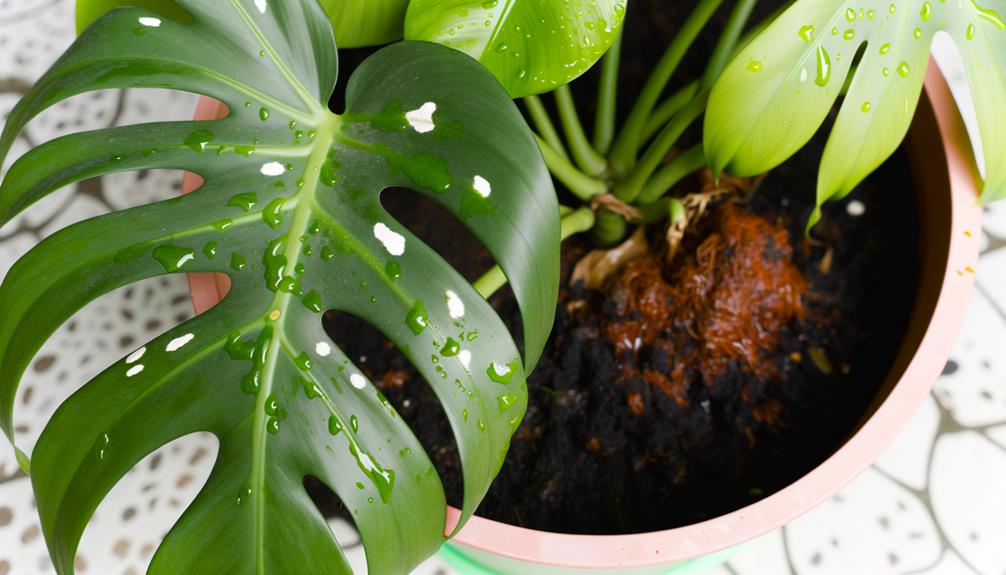
How does improper watering lead to white spots on Monstera leaves?
Overwatering or underwatering can stress your Monstera, causing white spots to appear. Waterlogged soil suffocates roots, leading to root rot and nutrient uptake disruption. Conversely, underwatering dehydrates the plant, impairing photosynthesis and causing chlorosis.
Here’s a detailed list of how improper watering affects Monstera leaves:
- Overwatering: Excess water in the root zone leads to root rot, visible as white spots due to fungal infections.
- Underwatering: Insufficient water results in cellular dehydration, causing leaf tissue damage and white spotting.
- Inconsistent Watering: Fluctuating moisture levels stress the plant, leading to irregular white spot patterns.
- Poor Drainage: Inadequate soil drainage exacerbates overwatering issues, promoting fungal growth and white spots.
Sunburn Damage
In addition to watering issues, exposure to intense sunlight can cause sunburn damage on Monstera leaves, manifesting as white or bleached spots. These spots result from chlorophyll degradation due to UV radiation, impairing the leaf’s photosynthetic efficiency. To prevent this, you should place your Monstera in indirect sunlight and avoid direct exposure during peak sunlight hours.
Here’s a table summarizing sunburn damage characteristics:
| Symptom | Cause | Preventive Measure |
|---|---|---|
| White/Bleached Spots | UV Radiation | Indirect Sunlight Placement |
| Crispy Leaf Edges | Dehydration | Regular Watering Schedule |
| Brown Patches | Sunburn Stress | Shield from Peak Sunlight |
| Leaf Curling | Heat Stress | Maintain Humidity Levels |
| Reduced Growth Rate | Photosynthesis Impairment | Balanced Light Exposure |
Temperature Extremes
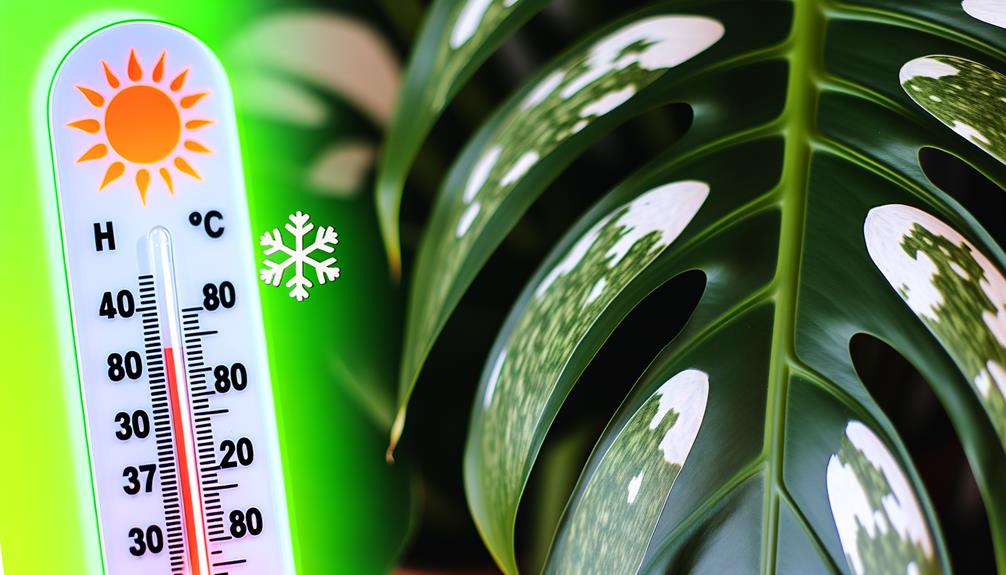
Temperature extremes can greatly stress Monstera plants, resulting in white spots and other symptoms due to disrupted cellular processes. When exposed to temperatures below 50°F (10°C) or above 85°F (29°C), Monstera cells can suffer damage, leading to visible white spots.
Consider these key points:
- Cold Stress: Prolonged exposure to low temperatures can cause cell walls to rupture, creating white, necrotic spots.
- Heat Stress: High temperatures accelerate transpiration, leading to dehydration and subsequent cellular damage.
- Thermal Shock: Sudden temperature changes disrupt cellular homeostasis, resulting in visible stress marks.
- Ideal Range: Maintaining a consistent temperature between 65°F (18°C) and 75°F (24°C) ensures healthy cellular function and prevents white spots.
Understanding these factors helps you maintain your Monstera’s peak health.
Humidity Problems
High or low moisture levels can significantly impact Monstera leaves, often resulting in the development of white spots due to disrupted moisture balance. Best moisture for Monstera is between 60-80%.
When moisture drops below this range, the leaves can suffer from desiccation, leading to cellular dehydration and white spots. Conversely, excessively high moisture fosters fungal growth. Fungi such as powdery mildew thrive in damp conditions, manifesting as white patches.
Regularly monitor indoor moisture with a hygrometer. If levels are too low, use a humidifier or place a water tray near the plant. For high moisture, improve air circulation with a fan.
Maintaining consistent, appropriate moisture levels is vital for preventing these issues and ensuring your Monstera thrives.
Chemical Exposure
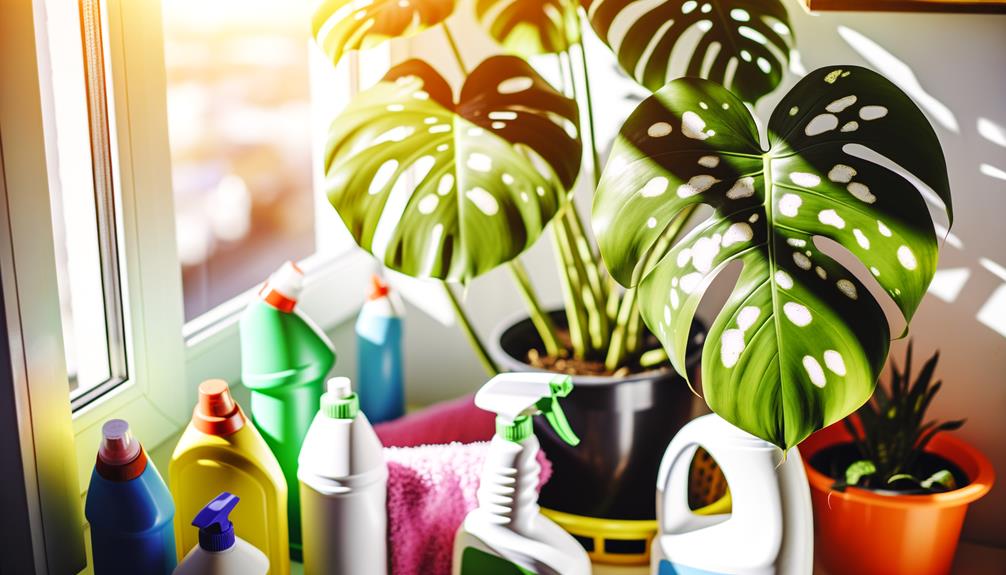
Chemical exposure can greatly affect your Monstera leaves, often resulting in white spots.
Pesticide residue can disrupt cell function, while overuse of fertilizers may lead to nutrient imbalances.
Additionally, poor water quality, especially water high in salts or chlorine, can damage leaf tissues.
Pesticide Residue Impact
Pesticide residues can cause white spots on Monstera leaves by disrupting the plant’s cellular processes and leading to chlorosis. This occurs when the chemical exposure interferes with the plant’s ability to produce chlorophyll, causing the leaves to lose their green pigment and develop white spots.
To mitigate this issue, you should:
- Rinse Leaves Thoroughly: After applying pesticides, rinse the leaves with water to remove any residual chemicals.
- Choose Organic Pesticides: Opt for organic alternatives that are less likely to harm your Monstera.
- Test Pesticides on a Small Area: Before widespread application, test the pesticide on a small leaf section to observe any adverse reactions.
- Follow Manufacturer’s Instructions: Always adhere to the recommended pesticide dosage and application frequency to minimize exposure risks.
Understanding these steps will help you safeguard your Monstera from pesticide-induced damage.
Fertilizer Overuse Effects
Excessive use of fertilizers can lead to chemical exposure that causes white spots on Monstera leaves. This disruption occurs due to nutrient uptake issues and the creation of toxic soil conditions. When you apply too much fertilizer, the soil accumulates high levels of salts and chemicals such as nitrogen, phosphorus, and potassium.
These imbalances interfere with the plant’s ability to absorb essential nutrients like calcium and magnesium. As a result, chlorosis and necrosis occur, which manifest as white or pale spots on the leaves.
Additionally, the roots may experience osmotic stress, impairing their function and causing further foliar damage. To mitigate these issues, it’s essential to follow recommended dosage guidelines, conduct periodic soil tests, and use slow-release fertilizers. These practices help maintain a balanced nutrient profile and promote healthy Monstera foliage.
Water Quality Issues
Poor water quality, laden with chemicals like chlorine and fluoride, can lead to white spots on Monstera leaves by causing oxidative stress and disrupting cellular functions. These chemicals can impede nutrient absorption, leading to chlorosis and necrosis in leaf tissues.
To ensure peak water quality for your Monstera, consider the following:
- Use filtered water: Filtration systems remove harmful chemicals, reducing oxidative stress on plant cells.
- Allow tap water to sit: Letting water sit for 24 hours allows chlorine to evaporate.
- Test water pH: Monstera prefers slightly acidic to neutral pH levels (6.0-7.0).
- Avoid water softeners: They add sodium, which can further stress the plant.
Physical Damage
Physical damage to Monstera leaves, such as tears or abrasions, can disrupt cell structure and lead to the appearance of white spots. When the leaf tissue is compromised, cellular fluids may leak, causing localized necrosis.
This process often manifests as white or translucent spots, signaling cellular death. Additionally, mechanical injuries can introduce pathogens, further exacerbating the issue.
Handling your Monstera with care is essential. Avoid brushing against sharp edges or placing the plant in high-traffic areas where it might get bumped. Pruning tools should be sterilized to prevent infections. Observing these practices minimizes physical damage, preserving the integrity of the leaves.
Conclusion
Imagine your Monstera thriving, its leaves a lush green tapestry unmarred by white spots. By addressing pest infestations, fungal infections, and bacterial diseases with precision, you safeguard its health.
Ensuring balanced nutrients, ideal watering, and stable temperatures prevents deficiencies and stress. Humidity control and avoiding chemical exposure further fortify its resilience.
Meticulously managing these factors, you create an environment where your Monstera can flourish, its leaves pristine and vibrant, a proof of your attentive care.



